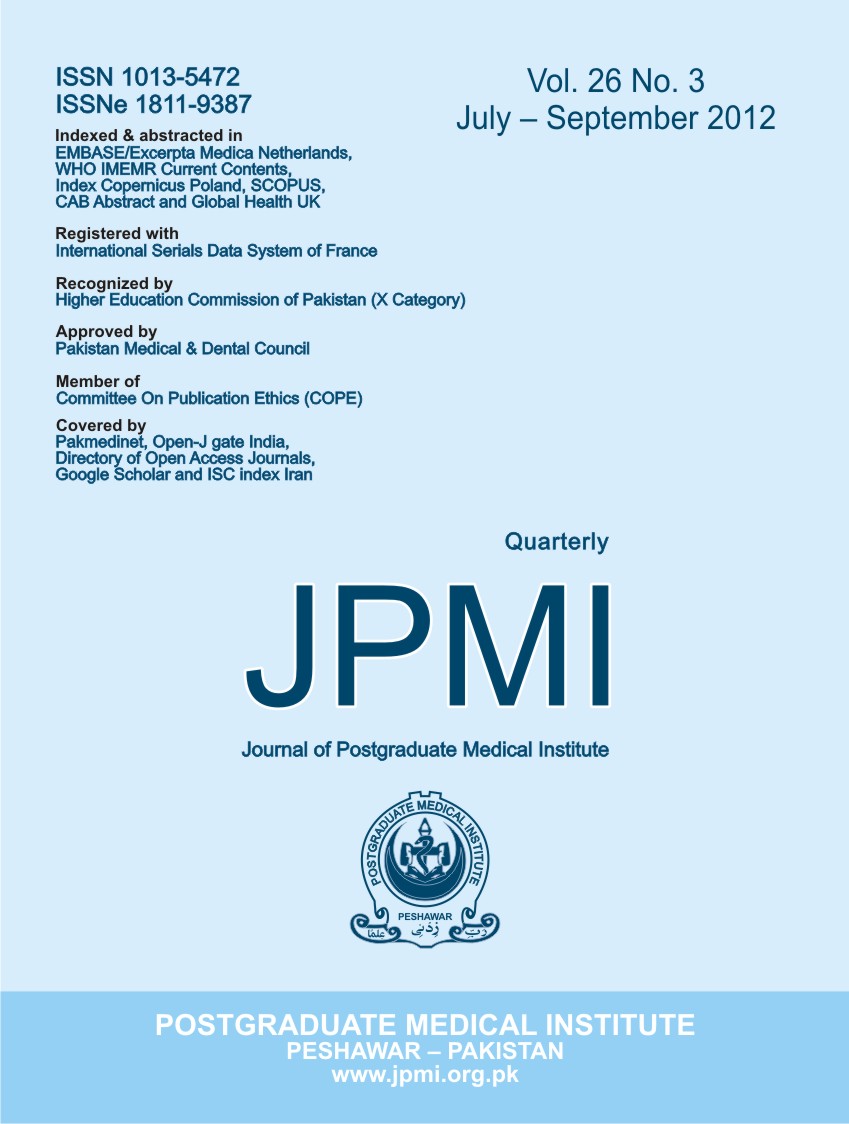FACTORS AFFECTING SERUM FERRITIN LEVEL IN SCHOOL GOING CHILDREN OF DISTRICT BANNU
Main Article Content
Abstract
Objective: To investigate the factors affecting serum ferritin level in school going healthy children in Distt
Bannu, Khyber Pakhtunkhwa and to know the potential risk in children associated with hypoferritinemia,
leading to microcytic hypochromic anemia in our population.
Methodology: This cross sectional study was carried out at Institute of Kidney Diseases (IKD) Hayatabad
Medical Complex Peshawar in one year time from March 2010- March 2011. A total of 113 healthy
children of both genders were selected with no history of bleeding, blood transfusion, any extensive
surgery or infections. 05cc blood sample was taken from each child. Out of which, 03cc were used for
ferritin estimation by using the Roche Elecsys 2010 Immunoassay Analyzer, while 02cc were used for basic
hematological examination, using Sysmex k-1000.
Results: There was no significant relationship between serum ferritin of boys and girls (p>0.05).However
boys had high ferritin level as compared to girls. While comparing serum ferritin in rural and urban areas
it has been observed that serum ferritin was high in rural areas. Moreover serum ferritin was positively
correlated with hygienic conditions (p=0.01) and dietary intake (p=0.00).
Conclusion: The finding of our study reveals that serum ferritin level is quite low in female population in
both urban and rural areas, hence anemia and low iron status are more prevalent in female population.
Environmental conditions, socioeconomic factors and diet habits are the main factors, which affect ferritin
level in children.
Bannu, Khyber Pakhtunkhwa and to know the potential risk in children associated with hypoferritinemia,
leading to microcytic hypochromic anemia in our population.
Methodology: This cross sectional study was carried out at Institute of Kidney Diseases (IKD) Hayatabad
Medical Complex Peshawar in one year time from March 2010- March 2011. A total of 113 healthy
children of both genders were selected with no history of bleeding, blood transfusion, any extensive
surgery or infections. 05cc blood sample was taken from each child. Out of which, 03cc were used for
ferritin estimation by using the Roche Elecsys 2010 Immunoassay Analyzer, while 02cc were used for basic
hematological examination, using Sysmex k-1000.
Results: There was no significant relationship between serum ferritin of boys and girls (p>0.05).However
boys had high ferritin level as compared to girls. While comparing serum ferritin in rural and urban areas
it has been observed that serum ferritin was high in rural areas. Moreover serum ferritin was positively
correlated with hygienic conditions (p=0.01) and dietary intake (p=0.00).
Conclusion: The finding of our study reveals that serum ferritin level is quite low in female population in
both urban and rural areas, hence anemia and low iron status are more prevalent in female population.
Environmental conditions, socioeconomic factors and diet habits are the main factors, which affect ferritin
level in children.
Article Details
How to Cite
1.
Khan MS, Shahnaz S, Sultana R, Ali I. FACTORS AFFECTING SERUM FERRITIN LEVEL IN SCHOOL GOING CHILDREN OF DISTRICT BANNU. J Postgrad Med Inst [Internet]. 2012 Jun. 29 [cited 2025 Dec. 13];26(3). Available from: https://jpmi.org.pk/index.php/jpmi/article/view/1294
Issue
Section
Original Article
Work published in JPMI is licensed under a
Creative Commons Attribution-NonCommercial 2.0 Generic License.
Authors are permitted and encouraged to post their work online (e.g., in institutional repositories or on their website) prior to and during the submission process, as it can lead to productive exchanges, as well as earlier and greater citation of published work.


